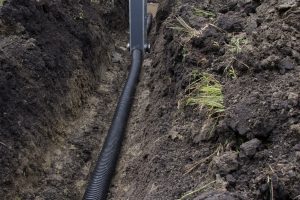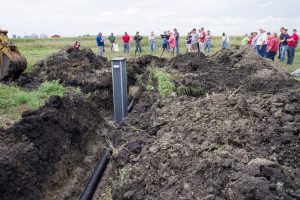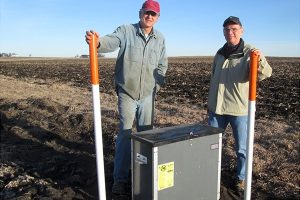Saturated Buffer: A water level control structure is installed near the outlet of a tile line, within or immediately adjacent to a new or existing stream buffer. A portion of the water is diverted into a tile line parallel to the stream and within or adjacent to the buffer. Water quality is improved as excess nitrate in the tile flow is converted to harmless nitrogen gas in the soil of the stream buffer due to organic matter and low oxygen.
Resources
Short Article
The Benefits of Buffers
Saturated buffers are a relatively new practice for improving water quality. The practice includes installing a water level control structure near the outlet of a tile line, within or immediately adjacent to an existing stream buffer. This modification of a field drainage system allows drainage water to flow as shallow groundwater through the buffer’s soil. A portion of the water is diverted into a tile line parallel to the stream and within the buffer.
Improving Water Quality
By allowing the drainage water to seep through the buffer soil, several natural benefits are realized. Excess nitrate in the tile flow is converted to harmless nitrogen gas (N2) in the soil of the stream buffer due to organic matter and low oxygen.
The advantages of saturated buffers include: low maintenance, reliability, relative ease of installment, and effectiveness at a reasonable cost.
(Sample quote to include expert) “Iowa is leading the way in designing this new edge-of-field practice,” says (Insert expert’s name and location). “Saturated buffers will play a key role in the Iowa Nutrient Reduction Strategy to improve water quality.”
The Challenges
The challenges for this practice include site specific soil investigations are required to determine if the practice can be applied and a buffer of perennial vegetation is needed. The site assessment and design must assure that impacts of impeded drainage on the cropland upstream are minimal and that streambank soils will remain stable with prolonged saturation.
Longer article – technical
The Benefits of Buffers
Saturated buffers are a relatively new practice for improving water quality. The practice includes installing a water level control structure near the outlet of a tile line, within or immediately adjacent to a new or existing stream buffer. This modification of a field drainage system allows drainage water to flow as shallow groundwater through the buffer’s soil. A portion of the water is diverted into a tile line parallel to the stream and within or adjacent to the buffer.
Improving Water Quality
By allowing the drainage water to seep through the buffer soil, a natural process is used to remove nitrate. Excess nitrate in the tile flow is converted to harmless nitrogen gas (denitrified) in the soil of the stream buffer due to the combination of organic matter, low oxygen and bacteria. The low oxygen is a result of the saturated soils produced in the buffer. The bacteria that remove nitrate require these low oxygen (anaerobic) conditions to use soil carbon to denitrify nitrate in the rerouted drainage water.
The advantages of saturated buffers include: low maintenance, reliability, relative ease of installment, and effectiveness at a reasonable cost. In fact, the initial investment may be lower than other drainage water quality practices.
The Challenges
The challenges for this practice include site specific soil investigations are required to determine if the practice can be applied and a buffer of perennial vegetation is needed. To reduce nitrogen loading, the saturated buffer will create a shallow water table. The site assessment and design must assure that impacts of impeded drainage on the cropland upstream are minimal and that streambank soils will remain stable with prolonged saturation.
There is also limited performance data available for this practice. However, initial data suggests it can be very effective at reducing nitrate loads to a stream. In addition, a saturated buffer may also help reduce the peak flow in a stream, as drainage waters may be attenuated within the buffer soil.
Implementation
For cost-effectiveness, consider locating the saturated buffer where it will intercept a subsurface drain outlet draining at least 15 acres. Also consider using other practices and management systems in conjunction with this practice – such as cover crops, drainage water management or a bioreactor – to achieve a reduction of nitrate levels.
Social Media Posts
Saturated buffers reduce nitrate loads by increasing denitrification, increasing plant uptake, and reducing flow to the stream.
Are you considering new edge-of-field practices such as a saturated buffer? Learn more (insert your site URL)
Edge-of-field practices such as saturated buffers play a key role in achieving #Iowa #waterquality goals. (add saturated buffer icon)
We’re hosting a field day (add date/location) featuring information re: saturated buffers. Attend & learn about improving your watershed.
Facebook Post
Reliable, effective, low maintenance all at a reasonable cost, what more could you ask for? Is it a new truck, a new tractor, new implement to make life easier? No, it’s a saturated buffer! A perfect start to improving #waterquality on your farm. Visit the IAWA website to learn more: https://www.iowaagwateralliance.com/saturated-buffers/




